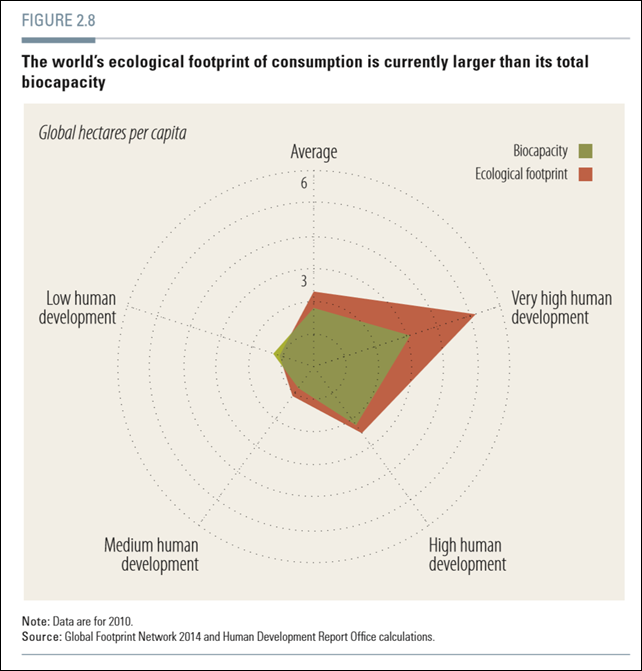Graph of the Day: World ecological footprint of human consumption
(UNDP) – Over the years there has been much debate about what sustainability means and about what measures can track sustainable progress— or the lack of it. In 2012 the United Nations Conference on Sustainable Development in Rio took a broad view that sustainable progress must cover all three dimensions that affect people’s life chances—social, economic, and environmental. Protecting the environment can be viewed as a good in itself, but Amartya Sen and others have argued that a more fruitful approach is to focus on the sustainability of people and their choices. Human beings have always depended on the bounty and resilience of the natural world. But it is clear that the future is precarious, thus increasing people’s vulnerabilities. Environmental degradation and climate change threaten the long-term survival of humanity. The challenge of sustaining progress is thus about ensuring that present choices and capabilities do not compromise the choices and freedoms available to future generations. While sustainability can be tracked through adjusted net savings and ecological footprints, these measures do not adequately reflect the dynamic nature of the choices available to people. An important aspect of this framing is that, in addition to requiring greater attention to the tensions that exist between present and future choices, it also highlights the need to protect human development gains from negative shocks and adverse events. The 2011 and 2013 Human Development Reports (HDRs) argued that environmental disasters could not only slow human development but even throw it into reverse. Climate change could become the single biggest hindrance to the ambitions of the sustainable development goals and the post-2015 development agendas. Environmental threats highlight potential tradeoffs between the well-being of current and future generations. If current consumption surpasses the limits imposed by our planetary boundaries, the choices of future and current generations will be seriously compromised. Whether a country or a community is on a sustainable development path depends on its position relative to local and global thresholds. A local threshold relates to the resources available within the boundaries of a country, while a global threshold takes a broader perspective by considering planetary boundaries. For instance, a country’s consumption of a natural resource might be well within its local threshold—due to resource abundance within its borders—but its per capita consumption might exceed the global threshold. Crossing these thresholds can have damaging consequences within and across borders, so it is important to explore how to balance these local and global boundaries. The universalist principle provides a good starting point for combining equity in the use of environmental and other resources within and across generations. Science provides an idea of the global thresholds for specific resources, while social justice requires that everyone have an equal claim to the resource available for use by the current generation. This enables us to identify countries on unsustainable development pathways, particularly on certain environmental indicators. Although the environment is a key dimension affecting the choices of current and future generations, it is not the only one. Economic, social and political factors also expand or restrict choices. Nonetheless, fairly well established thresholds of global environmental sustainability enable more formal assessments. Many countries, especially those in the high human development groups, now follow unsustainable development paths. Of 140 countries with data, 82 have ecological footprints above global carrying capacity. As a result, the world per capita footprint is substantially higher than the global sustainability threshold. Carbon dioxide emissions by 90 of 185 countries exceed the global threshold, and their emissions are large enough to push global per capita emissions above global sustainability. Fresh water withdrawals by 49 of 172 countries with data also exceed the global threshold. Overall, correlation is positive between higher HDI achievements and unsustainable ecological footprints and emissions, while water consumption is unsustainable across developing and developed countries. The world’s ecological footprint of consumption is currently larger than its total biocapacity, that is, the biosphere’s ability to meet human demand for material consumption and waste disposal (figure 2.8). The very high human development group, in particular, has a very large ecological deficit—as its ecological footprint is significantly larger than available biocapacity. While human development requires the expansion of choices currently available to people, it is also important to consider the impact on the choices of future generations—for intergenerational equity. Human development should not come at the cost of future generations. To secure and sustain human development and avert dramatic local and global repercussions, bold and urgent action on environmental sustainability is crucial.
